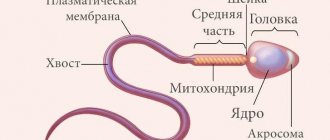Labiaplasty is primarily plastic surgery
After all, you can just trim it, or you can do it beautifully.
Recently, in my practice, I have come across situations where, for the sake of aesthetic ideas, doctors perform surgical procedures that do not take into account the physiological function of this area, subsequently having a pronounced impact on the quality of life of a woman. First of all, this concerns the labia minora and the clitoral hood; often these formations are excised excessively or completely, which is essentially a variant of that very “female circumcision”. And this is not happening somewhere in Somalia, but in large cities of European countries.
So, the main property of labiaplasty is that when performing it, the doctor must take into account the physiological function of the labia minora and the clitoral hood, and not turn it into mutilating circumcision. Unfortunately, women are not always explained what the minimum acceptable size should remain to fulfill its main protective function. Lately, patients have been turning to me with complaints about excessive excision of the labia minora; it is not always possible to help them; it is possible to straighten something, but it is impossible to regrow what has been cut off.
Female circumcision and human rights
Female circumcision is internationally recognized as a violation of the rights of girls and women and an extreme form of gender discrimination. Almost always, these operations are carried out among minors and are a violation of children's rights. The practice of female circumcision also violates the human rights to health, safety and bodily integrity, the right to be free from torture and cruel, inhuman or degrading treatment, and the right to life when these operations result in death.
On 11 May 2011, the Council of Europe Convention on preventing and combating violence against women and domestic violence (Istanbul Convention) was opened for signature, obliging states to accelerate measures to prevent female circumcision and support women subjected to this practice. Azerbaijan, Armenia and Russia have not signed this convention. On June 19, 2014, Georgia signed the document, but its ratification did not take place.
What are the labia minora and clitoral hood used for?
Let me remind you that the hood protects the clitoris from external influences, since its tissue is very delicate and contains a huge number of sensitive endings. Excessive removal of these folds can cause opening and rubbing against the underwear. Over time, the clitoris hardens and sensitivity disappears.
The labia minora close the entrance to the vagina, which is lined from the inside with very thin and vulnerable epithelium, which produces a moisturizing secretion. It is there that a huge number of sensitive endings are located. With excessive removal of the labia minora, constant contact of this epithelium with the external environment occurs, the mucous membrane dries out, becomes rough, and sensitivity sharply decreases. After childbirth, the entrance to the vagina will inevitably widen, and the genital slit will gape. In turn, this will lead to the involvement of more mucous membranes in contact with air, and the process will continue. Phenomena similar to atrophic ones will occur during menopause, when lack of hydration will lead to constant inflammation, itching, and the inability to have sex. All this, of course, will not happen immediately, but it will inevitably happen, so the doctor, when planning the extent of resection, must look somewhat ahead; this can only be done by a gynecologist, unfortunately not always by a plastic surgeon.
An incident from my life, a true story
A patient came to me with complaints of excessively enlarged and thickened labia minora. Upon examination, a duplication was revealed, this is a congenital condition when instead of two labia there are four labia, fused together in two. Unfortunately, I did not take photographs before the operation, and the patient did not provide them. The labia minora are thickened and enlarged. Approximately as it was in the photo below, only both looked like the left lip.
He proposed a variant of marginal wedge-shaped labiaplasty with a focus on the clitoral hood. That is, I took into account the peculiarity of a particular patient, when the clitoris is not very covered and is located immediately behind the fold. In this case, you cannot remove the excess fabric of the hood, otherwise the clitoris will be exposed. The operation initially assumed a variant of the result that could be classified as “better”, but not ideal solely due to the anatomical features and complexity of the situation. The labia minora could not be made thinner than they are without losing their shape, and the hood could not be touched.
After the operation, the patient was unhappy, sent photographs, I explained that some irregularities can be corrected, but the situation cannot be radically changed without loss of physiology. I can’t say that I consider the result as ideal, but the only possible one to preserve the function of the hood and labia minora. Again, I took into account the young woman’s prospects for childbirth in the future.
The patient independently went to another clinic, underwent surgery and presented the resulting option with a request to return the cost of the money spent.
Of course, it looks very neat, the only drawback is the loss of anatomy. In the photo, the labia have been almost completely removed and the clitoral hood has been resected. We will miss unevenness and other defects, that’s not the point. So, the entrance to the vagina has become bright pink; this is a cylindrical epithelium belonging to the vaginal mucosa. The photo clearly shows that the shade has become richer and brighter than in the previous image. An increase in color indicates that inflammation has begun, probably due to contact with the external environment. The clitoris is open in a calm state. After childbirth the situation will only get worse. But neat!
VARIETIES OF OPERATION
| Removing the clitoris itself or part of it (Sunnah) - this operation makes the clitoris more open and sensitive. It is considered more harmless in comparison with others. |
| Removal of the clitoris and labia minora (Excision) is the most common and cruel method. A woman loses the ability to receive pleasure from sexual intercourse. This custom is most widespread in the Republic of Kenya and Northern Egypt. |
| Cutting off the labia minora or majora, closing the surface of the wounds and closing the clitoris itself (Pharaonic circumcision). The entrance to the vagina is closed and a small opening remains for urination and menstruation. This method is even more cruel and raises more questions about why it needs to be carried out than answers. After the girl is married off, a small incision is made so that the male sexual organ can penetrate the vagina. During natural childbirth, the opening in the vagina is also cut. |
HOW TO REMOVE THE LAVADIA
The child is held on the bed, thighs spread, the eldest of the women kneels down and partially cuts off the clitoris and the edges of the labia with a razor blade. This “initiation into adulthood” takes about 5 minutes without any anesthetics, and the child’s whole body is burned with hellish pain. Relatives and friends they invited try to drown out the child’s screams with their cries. When the ritual action is over, everyone present rejoices at the girl’s entry into adulthood.
After the incision at the site of the removed labia minora has healed, a large scar forms in its place. A small diameter hole remains, into which a hollow reed is inserted to ensure the function of urination and to ensure the release of blood discharge during menstruation. This tradition is believed to ensure virginity before marriage. Having reached marriageable age, the girl undergoes another operation, which allows her to have sex with her husband. As a rule, this intervention is carried out after the wedding ceremony and consists of the following. The oldest woman makes an incision across the entrance to the vagina, after which a cylinder made of wood or a model of the penis, also made of wood, is inserted into the incision to make the vaginal entrance the desired size. The wooden cylinder remains in the vagina until the wound heals. Typically, the healing process in the most favorable scenario takes about two to three weeks.
Or the newly-made husband tries to perform the defloration ritual on his own. Usually, achieving penetration of a circumcised girl is very difficult: this sometimes takes more than one week, and often you have to call in a midwife with a sharp knife for help. The latter, however, is considered shameful for a man in those places (he is recognized as powerless before fulfilling his male duty), so the groom would rather take the knife in his hands than turn to someone else for help. Naturally, he has practically no idea about female anatomy, and the increased dose of alcohol in his blood usually adds courage to him in this matter...
It is difficult for a modern person to look at pictures and the process of female circumcision. It boggles the mind why little girls should be subjected to such terrible torment, after which they will never know the emotional side of sexual relationships. And here we are again faced with a deep, deeply rooted fear of a woman's supposedly limitless capacity for lust... Today, according to the UN, there are about 200 million girls and women living in the world who have undergone some form of genital mutilation and at least more three million are at risk each year from this practice of removing the labia minora and clitoris. Every year on February 6th Fr. But, despite all the UN attempts to ban them, the traditions of the peoples are too strong and rooted.
CONSEQUENCES
Despite the fact that this manipulation of circumcision of the labia minora is argued as cleansing a woman, preventing her promiscuity and performing reproductive functions, as studies by Swedish scientists have shown, infertility is 5-6 times more common in women who have undergone surgery than in those who who didn't do it. The child mortality rate is twice the average. After circumcision of the labia, a woman may experience heavy bleeding. Since the operation is performed in non-sterile conditions, non-surgical objects (usually a razor, knife and scissors) can cause infection. And the opinion that after circumcision a girl will not go into fornication is very contradictory...
Thus, from the point of view of international law, female genital mutilation is a serious assault on health, which is classified as a form of violence against women and gender discrimination, as well as violence against children.
From the author
This is why I prefer the term labiaplasty rather than resection. Labiaplasty is plastic surgery of the labia minora, and resection is simply cutting off. Before deciding to have an operation, you just need to imagine what the intimate area will look like afterwards and explain this to the surgeon, and he, in turn, must explain the harm of future intervention and suggest the volume that will balance aesthetic aspirations and physiology. The main principle: “Do no harm” should not be violated.
PS If you just need to remove the labia minora and clitoral hood, look for your doctor!
Author: obstetrician-gynecologist, specialist in intimate plastic surgery, Ivanov A.V.
Sources
- Auricchio V., Garzon S., Pomini P., Laganà AS., Casarin J., Cromi A., Ghezzi F., Vigato E., Franchi M. Clitoral reconstructive surgery after female genital mutilation: A systematic review. // Sex Reprod Healthc - 2021 - Vol29 - NNULL - p.100619; PMID:33845447
- Chappell AG., Soriano AJ., Percec I. The Role of Plastic Surgeons in Female Genital Mutilation Reconstructive Surgery. // World J Plast Surg - 2021 - Vol10 - N1 - p.104-107; PMID:33833961
- Shafaati Laleh S., Maleki A., Samiei V., Roshanaei G., Soltani F. The comparison of sexual function in women with or without experience of female genital circumcision: A case-control study in a Kurdish region of Iran. // Health Care Women Int - 2021 - Vol - NNULL - p.1-13; PMID:33797319
- Paixão M., Valente J., Leite A., da Silva AC., Chaves D., Silva L., Durval M., Lopes N., Teixeira V., Pedro V. . // Acta Med Port - 2021 - Vol - NNULL - p.; PMID:33775274
- Kartal YA., Yazici S. Female genital mutilation: Experiences, attitudes and perceptions of Somali female students living in Turkey. // Perspect Psychiatr Care - 2021 - Vol - NNULL - p.; PMID:33749836
- Earp BD., Shahvisi A., Reis-Dennis S., Reis E. The need for a unified ethical stance on child genital cutting. // Nurs Ethics - 2021 - Vol - NNULL - p.969733020983397; PMID:33719736
- Abdoli S., Masoumi SZ., Jenabi E. Investigation of prevalence and complications of female genital circumcision: A systematic and meta-analytic review study. // Curr Pediatr Rev - 2021 - Vol - NNULL - p.; PMID:33655839
- Akweongo P., Jackson EF., Appiah-Yeboah S., Sakeah E., Phillips JF. It's a woman's thing: gender roles sustaining the practice of female genital mutilation among the Kassena-Nankana of northern Ghana. // Reprod Health - 2021 - Vol18 - N1 - p.52; PMID:33648528
- No authors found COVID-19 hindering progress against female genital mutilation. // Lancet Public Health - 2021 - Vol6 - N3 - p.e136; PMID:33640072
- Dawson A., Wijewardene K. Insights into preventing female genital mutilation/cutting in Sri Lanka: a qualitative interpretative study. // Reprod Health - 2021 - Vol18 - N1 - p.51; PMID:33639963










